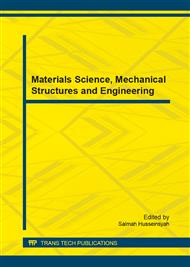p.7
p.11
p.15
p.23
p.27
p.32
p.38
p.42
p.46
Analysis of Mechanical Properties between Sugarcane Bagasse/LDPE Composites versus Coconut Coir Wax/LDPE Hybrid Composites
Abstract:
Development of new natural fiber composite for a good characteristic is the focus of many studies, because of their cellulose contents make their properties more potential. However, the main challenge in the research on natural fiber/ polymer composites is their poor compatibility. Based on that, the comparison study by chemical treatment of sodium hydroxide (NaOH) method and adding wax has been explored in two different processes to improve the compatibility of the natural fiber surface. The sodium hydroxide (NaOH) treated sugarcane bagasse (SCB) and coconut coir wax (CCW) in low density polyethylene (LDPE) as a reinforced matrix in fact, will enhance the mechanical properties of the resulting composites. In this study, four different compositions of (90/2, 90/4, 90/6, 90/8), with additional of 2% of NaOH and 2-8 % wax with sugarcane bagasse (SCB) / coconut coir respectively were tested. The specimens were analyzed by different techniques such as tensile test, hardness test, impact test and scanning electron microscopy (SEM) according to ASTM standard. This research has shown that the presence of NaOH indicates higher tensile strength and impact strength compared to coconut coir wax (CCW). While for the young modulus and hardness test value shows coconut coir wax (CCW) has increased and improved. The morphological analysis was conducted to determine the effects of natural fiber bonding between the matrix materials for broken specimens after mechanical testing.
Info:
Periodical:
Pages:
27-31
Citation:
Online since:
October 2014
Authors:
Keywords:
Price:
Сopyright:
© 2014 Trans Tech Publications Ltd. All Rights Reserved
Share:
Citation:


